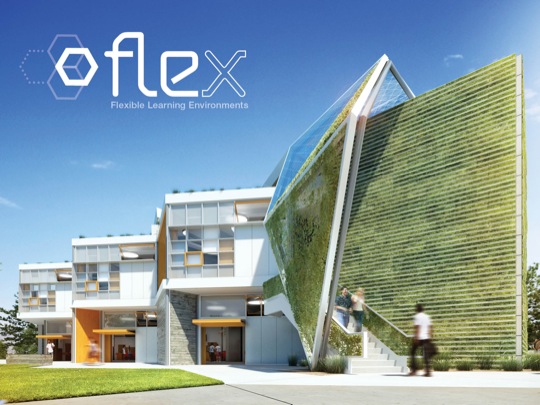By James Krueger, Senior Project Designer
In 2010, Los Angeles Unified School District (LAUSD) held a design competition for a flexible solution to replace portable buildings across the district, and HMC Architects accepted the challenge. The district asked us to ignore their standards and put an emphasis on an ideas-based approach. They wanted creative, progressive responses to their problem—not dressed-up modular buildings. We challenged the traditional box shape of the classroom by looking at how the room is used—and how it is currently under utilized. Although our design solution, which we named Flex, did not win the competition, our end product is a portable classroom solution that can used at any school, and we hope our design can inspire other school districts to think differently when it comes to portable classrooms.

Before we could begin brainstorming design solutions for the competition, we dove into some research about teaching philosophies. The future of teaching is becoming more and more about tailored individual instruction, self-guided instruction, and group learning activities. Socrates believed in enabling students to think for themselves, rather than filling their heads with “right” answers. He regularly engaged his pupils in dialogues by responding to their questions with questions, instead of answers. This process, known as the Socratic Method, encourages divergent thinking rather than convergent. Students are rearranged to face each other in the classroom, and are given opportunities to examine a common piece of work, whether it is in the form of a novel, poem, art print, or piece of music. After studying the common piece, open-ended questions are posed. Open-ended questions allow students to think critically, analyze multiple meanings in text, and express ideas with clarity and confidence. Participants feel a certain degree of emotional safety when they understand that this format is based on dialogue and is not necessarily a debate.
Dialogue is exploratory and involves the suspension of biases and prejudices. Discussion/debate is a transfer of information designed to win an argument and bring closure. Once teachers and students learn to dialogue, they find that the ability to ask meaningful questions that stimulate thoughtful interchanges of ideas is more important than “the answer.” Participants in a Socratic Seminar respond to one another with respect by carefully listening instead of interrupting. Students are encouraged to “paraphrase” essential elements of another’s ideas before responding, either in support or in disagreement. Members of the dialogue look each other in the eyes and use each other’s names. This simple act of socialization reinforces appropriate behaviors and promotes team building.
Now imagine if a classroom flexed with these needs in mind and encouraged dialogue.

We started the design process by examining the standard classroom “box.” First, the teaching wall is usually centered on one wall, all students facing forward. This follows the “I teach, you listen and take notes” model of instruction. Second, the two sides and back wall of the classroom are mostly used for hanging student work, fixed computer stations, large displays, maps, or storage. Third, and most important, the corners of the box-shaped classroom are largely unused for instruction due to the fact that they are hard to see from the opposite sides of the room. These corners are often used as informal storage areas (clutter). The real estate that is usable for instruction on a 30’ long teaching wall is actually about 20’ due to sight lines.
These realizations about the classroom “box” led us to a hexagon layout. With a hexagon, the teacher has three walls instead of one for instruction, and each wall is centrally focused back to the student to create a panoramic display. The walls can also integrate technology such as smart boards, flat panel monitors, student voting/scorekeeping, sliding marker boards with storage, and even fold out tables. And by introducing a hexagonal layout, both standard classroom configurations (teacher lecturing class), and informal instruction (group work/study sessions) work well within this configuration. Also, the connection between classrooms is enhanced. With the box, there are three interior and one exterior connection, however, the hexagon has two more walls to work with, and so you can have up to five interior connections.
[nggallery id=66]
The hexagon shaped classroom is not a new idea. Past explorations had varying levels of success based on the technology at the time. There are now a plethora of systems on the market that perform at rates never before seen. From movable wall systems, to sound-absorbing materials, to resilient finishes, we now have the technology to make the hexagon classroom a success.
Sustainable strategies were integrated from the outset to create a space that was designed for quick assembly/disassembly and built from recycled materials. We also explored integrating photovoltaic panels, green screens, rainwater harvesting, chilled beam system, dry fixtures, grey-water reuse, low carbon materials, and zero waste construction.
In the case of the classroom, form follows function as the space conforms to the student and teachers’ needs (not the other way around). Due to the uniformity of the shape, all beams, columns, and wall panels/storefront systems can be the same size. Using Flex, the entire school can be mass produced in a factory and shipped to the site for quick assembly. Also, panels are interchangeable, and customization has endless possibilities. An interior modular learning system can be integrated using a kit-of-parts to create endless configurations. The hexagon can also be configured to accommodate a variety of spaces including but not limited to administration, library, food service, multi-purpose, or indoor dining.
[nggallery id=67]
Imagine the infinite possibilities when new design solutions meet and direct the changing landscape of classroom instruction.
For more information about Flex, contact Senior Project Designer James Krueger.
